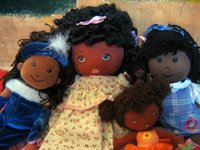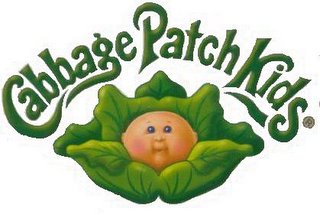Kenneth Clark's Doll Study and My Toy Box
 As a little girl, I loved dolls. One might say that I was obsessed with them. I had cuddly rag dolls, tiny dollhouse dolls, life-sized baby dolls and a flock of Barbies.
As a little girl, I loved dolls. One might say that I was obsessed with them. I had cuddly rag dolls, tiny dollhouse dolls, life-sized baby dolls and a flock of Barbies.And not one of them was blond.
 My parents didn't allow us to have white dolls. If someone gave us a standard Caucasian Barbie doll, it would mysteriously disappear to be replaced by a chocolate-skinned Christie doll. While I do remember once gazing longingly at a friend's Malibu Barbie and wishing that she was mine, for the most part, I was happy with my dolls. If I absolutely HAD to have a white doll, I would carefully paint its skin and eyes brown before it was "mine".
My parents didn't allow us to have white dolls. If someone gave us a standard Caucasian Barbie doll, it would mysteriously disappear to be replaced by a chocolate-skinned Christie doll. While I do remember once gazing longingly at a friend's Malibu Barbie and wishing that she was mine, for the most part, I was happy with my dolls. If I absolutely HAD to have a white doll, I would carefully paint its skin and eyes brown before it was "mine".When I was finally old enough to buy my own dolls, my mother told me about a study on dolls and race. Back in the 40s and 50s, black psychologist Dr. Kenneth Clark showed black and white dolls to school children and asked them which dolls were “pretty” and “nice,” and which ones were “bad”. While the white kids preferred the white dolls, so did 75% of the black kids. To most of the black children, the black dolls were just "bad". Really "bad". So "bad" that when Clark asked them which dolls looked more like themselves, some chose the white dolls, some couldn’t answer, and some just burst into tears.
After hearing about that study, I never thought about dolls the same way. I never did go on that Blond Barbie-buying spree. In fact, I started sewing black dolls of my own. And then an amazing thing happened.

In the mid-eighties, formerly sane Americans of all races completely lost their minds over a new toy on the market -- The Cabbage Patch Kid. Created by Georgian artist Xavier Roberts, each doll was "born" at a magical place named "Babyland General", stamped on the booty with Robert's signature and sent to the store with its very own name on its very own birth certificate. The fact that these dolls shot right off the "cute" scale into "borderline grotesque" was completely missed by all of us (but with all those huge hairstyles and shoulder pads blocking our collective view, it was easy for us to miss).
Everyone wanted to "adopt" one of these dolls, which came in different ethnicities. But the supplies were limited and Christmas was coming. So when shipments arrived and the stores opened, everyone scrambled to grab the boxes from the shelves before they were all gone. It was mayhem, madness. Suburban white parents starting fist fights in the doll aisle of the Toys R Us. I'd never seen anything like it.
But the best part came months later. Because supplies were so limited and people were desperate to take whatever doll they could, there were many white children who received a black doll for Christmas or Hanukkah. I can't tell you how many times I saw some little blond or redheaded girl cuddling a cocoa brown Cabbage Patch Kid like she'd just given birth to it herself. These children appeared to adore their black baby dolls just as much as I adored mine. I'd never seen anything like that either.
The Cabbage Patch Kid craze finally died down after a few years. Doll studies in 1987 revealed that more children of both races still chose white dolls over black dolls. So that whole "fad toy transcending race" thing really only lasted for a moment.
But for this black girl, it was an amazing moment.

2 Comments:
Very nice post. One thing I could never understand about Clark's study is how he and others concluded that if most Black girls thought that white dolls were more beautiful, it meant that Black children needed to attend integragated schools. I understood the whole inferority complex revealed in the doll study, but I just can't figure out how they concluded white-black school integragation would solve the inferority problem for Black children.
cool stuff.
you're invited to visit my blog, although it's admittedly less cheerful than yours.
i focus on multculturalism in the advertising industry. and this month, i'm featuring black history month ads.
all the best.
Post a Comment
<< Home